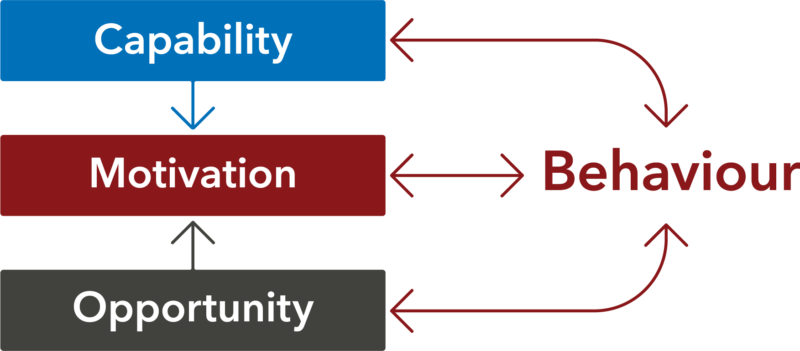Everything starts and ends with people.
Public services exist to improve people’s lives—to deliver public transportation, improve health outcomes, ensure safety, or to provide access to education. These services are most effective when their design is informed by an evidence-based understanding of human behaviour.
Yes, public services require technology, infrastructure, and traditional economic levers to function, but ultimately, their success relies on how humans interact with them. In our experience, too many public services are designed and rolled out that have not taken this understanding of human behaviour into account. There is an opportunity to integrate this approach in cost-effective ways and significantly improve the experience and outcomes of these services.
By embedding behavioural science into public service delivery, governments can increase the effectiveness of programs, improve operational efficiency, and boost citizen satisfaction and trust.
Finite public sector resources are precious. Every dollar, every hour, every program should deliver real impact. By embedding behavioural science into public service design and delivery, governments can increase the effectiveness of programs, improve operational efficiency, and boost citizen satisfaction and trust. It’s not just a smart idea—it’s essential to modern, responsive, and human-centred public services.
In our work at Davis Pier, we use behavioural science theories and methods to connect the dots between service design, technology, and human behaviour. While behavioural scientists often leverage extensive bodies of research and large amounts of data in their methods, applying behavioural science doesn’t need to be complicated. It can be easily integrated into public policy with the standard use of a simple yet powerful approach like the COM-B Model.
COM-B Model for Behaviour Change
The COM-B Model centers on capability, opportunity, and motivation as key enablers of behaviour and behaviour change.
The model can help governments and public sector organizations create services that people will use, value, and benefit from.

The COM-B model identifies three essential factors that drive behaviour:
- Capability (C). Do people have the physical and psychological skills to perform the behaviour?
- Opportunity (O). Does the environment support or hinder the behaviour?
- Motivation (M). Do people want or need to engage in the behaviour?
Behaviour (B) happens when all three—capability, opportunity, and motivation—come together. No behaviour change happens unless all three elements are addressed.
For a deeper understanding of COM-B, read this study published in Implementation Science.
How COM-B Improves Public Service Design
Let’s break down exactly how using COM-B can improve the design and delivery of public services:
1. Diagnosing the Real Barriers to Action
COM-B provides a structured way to diagnose the real barriers to desired behaviours. This ensures that interventions to deliver public services will target the underlying drivers of behaviour change.
For example, imagine a city that recently launched an e-bike program to reduce car trips and cut emissions, but participation rates remain low. Many residents continue relying on cars for short urban journeys—suggesting that simply providing access to e-bikes isn’t enough to drive widespread adoption. To understand why more urban residents aren’t switching from car trips to e-bikes for commuting and errands, let’s take a look at what a behavioural diagnosis using the COM-B model can reveal:
- Many residents are unsure how far e-bikes can travel or whether they are safe to ride in traffic (capability barrier)
- Convenient and secure places to store and charge e-bikes are hard to find (opportunity barrier)
- Residents see e-bikes as expensive and not worth the financial investment (motivation barrier)
2. Designing and Testing Evidence-Based Interventions
Once the barriers are diagnosed, we can design interventions to directly tackle the barriers to behaviour change. This means building people’s capabilities, re-shaping the opportunities they have access to, and strengthening their motivation.
Examples of effective interventions might include:
- Free “try-an-e-bike” sessions in local neighbourhoods to build resident knowledge on how e-bikes work and build their skills and confidence (capability enabler)
- Installation of secure parking and subsidized charging stations in popular areas that are accessible and convenient to residents (opportunity enabler)
- Financial incentives and low-interest financing to reduce upfront cost barriers to acquiring e-bikes (motivation enabler)
Even well-designed interventions can fall short if they aren’t tested first. What looks promising on paper might not translate into real-world impact because people’s behaviours depend heavily on context—what works in one context won’t necessarily translate to all. That’s why, before scaling up, it’s essential to pilot and test these interventions to evaluate how they perform in the real world.
Before scaling up, it’s essential to pilot and test behavioural interventions to evaluate how they perform in the real world.
Testing in a smaller location or with specific communities helps uncover whether the solutions are practical, appealing, and actually changing behaviour as intended. Prototyping allows teams to gather data on participation rates, usage patterns, and barriers that may still be getting in the way.
By learning what works—and what doesn’t—programs can be adapted to better fit people’s needs and ensure that resources are invested in approaches that are truly effective and equitable.
3. Improving Equity
By looking closely at what stops different groups from acting, the COM-B model helps make behaviour change efforts more inclusive and responsive to people’s context-specific needs. Instead of assuming everyone faces the same barriers, this approach reveals the unique pain points that different communities might experience, whether it’s:
- Having the digital literacy skills to access and complete our forms (capability)
- Having the transportation needed to access our services (opportunity)
- Lacking the belief that engaging with a service will make a difference due to past negative experiences with systemic inequities (motivation)
Public services need to work for all the people they are meant to serve. By applying the COM-B model alongside service design methods, we can ensure services are intentionally inclusive and proactively work to reduce barriers to participation.
4. Enhancing Public Engagement
We believe engagement isn’t just about communication—it’s about the follow through. It’s about creating services that fit people’s lives and reflect their priorities.
When public services use COM-B:
- communications become tailored, timely, and influential.
- residents feel heard and respected.
- trust between government and the public grows.
- uptake and success rates of services grow, too.
What’s Next?
When public services are thoughtfully designed, they can encourage decision-making and drive behavioural outcomes where people, service providers, and communities all benefit. By bringing behavioural science and the COM-B model into your design process, you can create services that truly work for people, not just on paper, but in the hum of everyday life.
The Davis Pier team believes that leveraging behavioural science is key to building better services with our clients and communities.
If you’re interested in learning more or applying this approach to your work, we’re here to help.
Raquel Rosas (she/her) is an Associate at Davis Pier and a registered Health Psychologist focused on behaviour change. With an extensive background in health promotion, she applies a behavioural science lens and health psychology principles across a range of societal challenges, including health and wellbeing, sustainability, and workplace safety.
Eliza-Jane Stringer (she/her) is a Principal at Davis Pier and a Behavioural Scientist with experience in the public sector in Canada, Australia, and the United Kingdom. She has applied behavioural insights across a range of policy areas, including employment, health and wellbeing, transportation, workplace safety and environmental preservation.



